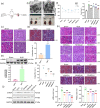Network Pharmacology Analysis and Machine-Learning Models Confirmed the Ability of YiShen HuoXue Decoction to Alleviate Renal Fibrosis by Inhibiting Pyroptosis
- PMID: 37900883
- PMCID: PMC10612518
- DOI: 10.2147/DDDT.S420135
Network Pharmacology Analysis and Machine-Learning Models Confirmed the Ability of YiShen HuoXue Decoction to Alleviate Renal Fibrosis by Inhibiting Pyroptosis
Abstract
Purpose: YiShen HuoXue decoction (YSHXD) is a formulation that has been used clinically for the treatment of renal fibrosis (RF) for many years. We aimed to clarify therapeutic effects of YSHXD against RF and potential pharmacological mechanisms.
Materials and methods: We used network pharmacology analysis and machine-learning to screen the core components and core targets of YSHXD against RF, followed by molecular docking and molecular dynamics simulations to confirm the reliability of the results. Finally, we validated the network pharmacology analysis experimentally in HK-2 cells and a rat model of RF established by unilateral ureteral ligation (UUO).
Results: Quercetin, kaempferol, luteolin, beta-sitosterol, wogonin, stigmasterol, isorhamnetin, baicalein, and dihydrotanshinlactone progesterone were identified as the main active components of YSHXD in the treatment of unilateral ureteral ligation-induced RF, with IL-6, IL1β, TNF, AR, and PTGS2 as core target proteins. Molecular docking and molecular dynamics simulations further confirmed the relationship between compounds and target proteins. The potential molecular mechanism of YSHXD predicted by network pharmacology analysis was confirmed in HK-2 cells and UUO rats. YSHXD downregulated NLRP3, ASC, NF-κBp65, Caspase-1, GSDMD, PTGS2, IL-1β, IL-6, IL-18, TNF-α, α-SMA and upregulated HGF, effectively alleviating the RF process.
Conclusion: YSHXD exerts important anti-inflammatory and anti-cellular inflammatory necrosis effects by inhibiting the NLRP3/caspase-1/GSDMD-mediated pyroptosis pathway, indicating that YSHXD represents a new strategy and complementary approach to RF therapy.
Keywords: YiShen HuoXue decoction; machine-learning; molecular docking simulation; pyroptosis; renal fibrosis.
© 2023 Feng et al.
Conflict of interest statement
The authors declare that there are no conflicts of interest in this work.
Figures









References
MeSH terms
Substances
LinkOut - more resources
Full Text Sources
Research Materials
Miscellaneous

